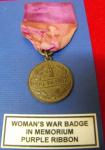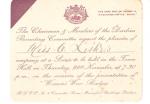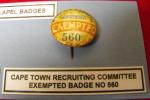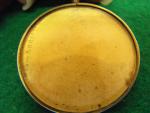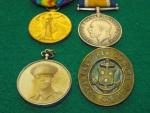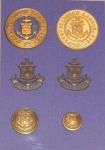
sabrigade
For Deletion-
Posts
1,707 -
Joined
-
Last visited
-
Days Won
34
Content Type
Profiles
Forums
Blogs
Gallery
Events
Store
Everything posted by sabrigade
-
IN MEMORIUM CERTIFICATE: CPL LISTER Corporal Lister was one of 500 men, who joined the Natal Light Horse in August, 1914. They enlisted for the German South West Africa campaign and were commanded by Lt-Col Royston. During the campaign the Regiment served on the southern frontier and was part of the Central Force. On 27 April 1915, a major engagement took place near and at Gibeon Station. The German forces were able to deliver heavy machinegun and rifle fire which resulted in heavy losses for the Natal Light Horse. 3 Officers and 21 other ranks were killed and 49 were wounded. Corporal Lister was one of the other ranks that were killed in action. The Regiment was disbanded in June, 1915. As part of the Durban Recruiting Committee’s ongoing program, a certificate was sent to his sister Miss C. Lister on a farm near “Gillette”. The certificate is signed by the Chairman of the Recruiting Committee and the campaign details are hand-written “GSW Africa 1915” as is his name and unit.
-
http://gmic.co.uk/uploads/monthly_02_2012/post-3034-0-69860500-1328960759.jpghttp://gmic.co.uk/uploads/monthly_02_2012/post-3034-0-35200200-1328960785.jpg DURBAN RECRUITING COMMITTEE ROLL OF HONOR A document was issued by the Durban Recruiting Committee in Durban on 21 November 1918. This date coincided with the presentation of the badges to the female recipients of the committee’s badges. The list included those South Africans who were killed in action or who had died of wounds or disease.
-
THE DURBAN RECRUITING COMMITTEE WOMEN’S WAR BADGES It would appear as if there were two badges presented. The first type of badge was presented to a lady in recognition of her soldier’s service to his “King and Empire”. In other words, the serviceman had not made the supreme sacrifice. The badge remained the same but was suspended from a blue, white and red ribbon. The second type of badge was issued In Memoriam where a service man had died as a result of enemy action or where he had died of wounds or disease. The badge was suspended from a purple ribbon.
-
INVITATION FOR “WOMEN’S WAR BADGES” PRESENTATION Miss C. Lister, sister of the late Corporal H. Lester, was invited by the Chairman and Members of the Durban Recruiting Committee. The invitation was to a Soiree at the Durban Town Hall on 21 November 1918 at 19h30 where the Women’s War Badges were to be presented. The invitation card was to be handed in as an exchange for the badge. As Miss Lister kept her invitation, it is therefore unlikely that she received her badge and may not even have attended the function. R.S.V.P was to be confirmed at the No 4 Committee Room at the Municipal Building in Durban.
-
DURBAN RECRUITING COMMITTEE BADGES The Committee decided that a Badge was to be issued and presented to the “women of Natal” for the sacrifice that they had made in their support to the First World War. The words civilization and humanity were used. The badges were to be given to wives and/or mothers or the closest blood related lady to a serviceman who had died, been incapacitated or who was still serving in the theaters of war where South African soldiers were deployed. Active service was a requirement. The females were required to be residents in District 5 which was the Durban coastal region. Ladies who complied with the requirements were requested to submit applications and details of the specific servicemen to the Committee. The details where possible were to include, where and if possible, force number, full names, unit in which served or still serving and other relevant information to assist the Committee. A specific time and place would be announced to present the awards to the ladies.
-
High schools were encouraged to volunteer and proved to be a very enthusiastic source for recruitment. This group included scholars, old boys and even teachers. As the war continued and heavy losses were experienced, enthusiasm did not wane but memorials were set up at various schools. At the “outbreak” of peace on 11 November 1918, celebrations in Durban continued for a week. The Recruiting Committees were amalgamated with returned soldiers Advisory Boards and Employment Committees. A dispersal camp was established in Durban for soldiers who returned from East Africa. Some committees issued Returned Soldiers lapel badges.
-
After the German South West African campaign and the internal 1914 rebellion had been successfully concluded, the Union of South Africa offered to send forces to assist in the campaigns in East Africa and in Europe. A Director for war recruiting was appointed and War Recruiting Committees were formed throughout the country. There were 141 of these committees. The committees consisted of mayors, counselors and other leading citizens of the specific town or city. Recruiting campaigns were particularly and specially planned and were conducted by selected personnel and officers. The Durban Recruiting Committee was well known for the amount of work that was carried out during this time. Mass public meetings were held at the town hall and other venues. The most memorable occasion was a weeklong rally and a smoking concert held at a leading hotel in Durban. The town was also canvassed for potential manpower. Eligible manpower was regarded as men between the ages of 18 and 45 who were not already in active service. The committee utilized experienced military men and was therefore able to confirm who was medically unfit, in government service, employers who had confirmed them as key personnel, those with dependents, whose parents would not let them join and finally those who refused to. Durban and Pietermaritzburg organizations were supportive of their employees who had joined and ensured that they did not suffer any monetary losses. Many municipal employees from both cities had enlisted. The committee considered exemption badges for medically unfit potential candidates. This was to spare them from the humiliation of receiving the notorious “white feather treatment” where they would be accused of cowardice for not enlisting by the female population. Although other committees issued exemption badges, the Durban committee decided against it as there report stated that the men often neglected to wear them and therefore defeated the purpose of the badge. Other committees issued badges and this included the Durban branch of the Victoria League. These badges were usually numbered and were worn as lapel badges.
-
THE DURBAN RECRUITING COMMITTEE There were strong pro-war sentiments from the people of Natal when the First World War was declared. Fund raising and recruiting became a successful collaboration between the government and civil society. The purpose of the committee was to secure men for military service. Natal supplied a large number of men for military service and service was voluntary and not compulsory. At the outbreak of the war, General Botha made a request for additional volunteers for the planned campaign in German South West Africa and also to take over the responsibilities of the imperial military garrison that had been withdrawn from South Africa. To find information on the committee and related aspects proved very difficult and took a while to find and a lot more research may be required. Natal was divided into two military districts at the time. District No 4 was inland at Pietermaritzburg and District No 5 was at the coast in Durban. Mass meetings were held in the two centers and General Botha’s initial request for 7000 volunteers was quickly satisfied and even exceeded. This enabled a second battalion of the Durban Light Infantry to be formed in Durban. In Pietermaritzburg the Natal Light Horse was established and it consisted of men who had not been able to get into the other units.
-
Captain Roberts attested at the age of 36 with the rank of temporary sergeant. His previous service indicated 3 months duty as a member of the Civic Guard during the 1914 rebellion in South Africa. He was "discharged" on 31 July 1917, the reason was for the good reverend to be appointed as a 2nd Lieutenant in the 1st South African Infantry Brigade. It was noted that his military character was "Very Good" and that his profession was that of a "Clerk in Holy Orders". Appointed a Drafts Escorting Officer on 7 August 1917, he then joined the 1st South African Infantry Brigade as part of the 2nd Reserve Battalion of the South African Infantry. On the 31st of October 1917, Captain Roberts was appointed as the Chaplain of the 1st South African Infantry Regiment. During the Geman offensive of April 1918, the 1st South African Infantry Brigade was heavily involved and committed. Due to losses, the "Brigade" was reformed and consisted of 39 officers and 1473 men. From 9 to 9 April 1918, the Brigade held the positions between Messines Ridge and Lumm's Farm. On the 10th of April at 17H45, the Brigade launched an assault on the Messines Ridge. The 1st Regiment, with their chaplain being present, carried out a bayonet charge and was involved in hand-to -hand combat. During this engagement, Captain Roberts was "slightly wounded in the right shoulder". He recieved treatment and was discharged back to duty on 19 April 1918. Over the period 10 to 13 April 1918, the Brigade suffered 639 casualties during the intense fighting. Captain Roberts's wife was informed of his wound on 12 April 1918. As the First World War quickly drew to a conclusion, Captain Roberts was appointed as the Brigade Educational Officer on 25 October 1918. The war ended 17 days later. On 13 June 1919, he was released from service and at the same time relinquished his temporary Imperial Commission. He then resumed his normal status as a temporary second lieutenant on the supernumary list of the Active Citizen Force.
-
Cape Coloured Labour Regiment
sabrigade replied to sabrigade's topic in Great Britain: Orders, Gallantry, Campaign Medals
I have a researcher working on finding the file and/or any other information that is available. I believe that the British government paid for the issue of the medals to the Cape Coloured Labour Regiment and I that they were the only "complete" South African unit to be issued with the British Victory Medal. Thank you for the comments. -
Cape Coloured Labour Regiment
sabrigade replied to sabrigade's topic in Great Britain: Orders, Gallantry, Campaign Medals
REVERSE OF THE BRITISH PATTERN VICTORY MEDAL I am waiting for research on Private Arendse and will update the posts when I receive any information. -
Cape Coloured Labour Regiment
sabrigade replied to sabrigade's topic in Great Britain: Orders, Gallantry, Campaign Medals
http://gmic.co.uk/uploads/monthly_01_2012/post-3034-0-34822400-1326608010.jpghttp://gmic.co.uk/uploads/monthly_01_2012/post-3034-0-64374500-1326608029.jpg VICTORY MEDAL Because the Cape Coloured Labour Regiment was regarded as an "Imperial Service Unit", they were awarded the British and not the South African pattern Victory Medal. -
Cape Coloured Labour Regiment
sabrigade replied to sabrigade's topic in Great Britain: Orders, Gallantry, Campaign Medals
http://gmic.co.uk/uploads/monthly_01_2012/post-3034-0-81241000-1326607761.jpghttp://gmic.co.uk/uploads/monthly_01_2012/post-3034-0-46951900-1326607799.jpg BRITISH WAR MEDAL 1914 - 20 -
Cape Coloured Labour Regiment
sabrigade replied to sabrigade's topic in Great Britain: Orders, Gallantry, Campaign Medals
http://gmic.co.uk/uploads/monthly_01_2012/post-3034-0-26975700-1326607385.jpghttp://gmic.co.uk/uploads/monthly_01_2012/post-3034-0-46930100-1326607406.jpghttp://gmic.co.uk/uploads/monthly_01_2012/post-3034-0-93972000-1326607425.jpg PORTRAIT PHOTOGRAPH OF PRIVATE ARENDSE IN A HALLMARKED SILVER FRAME -
Cape Coloured Labour Regiment
sabrigade replied to sabrigade's topic in Great Britain: Orders, Gallantry, Campaign Medals
http://gmic.co.uk/uploads/monthly_01_2012/post-3034-0-58155600-1326607117.jpghttp://gmic.co.uk/uploads/monthly_01_2012/post-3034-0-75030900-1326607145.jpg CAPE COLOURED LABOUR REGIMENT VOIDED CENTRE TYPE BRONZE METAL CAP BADGE AND BACKING WORN BY PTE ARENDSE -
Cape Coloured Labour Regiment
sabrigade replied to sabrigade's topic in Great Britain: Orders, Gallantry, Campaign Medals
Private Arendse was a young member who joined and accompanied his unit to France. I am very fortunate to have obtained his medals, cap badge and portrait as a complete set. -
This unit was formed in 1916 for service on the Western Front. Badges and items to them are very scarce and are seldom. As an introduction, the following badges and items are in the photograph, from left to right, top to bottom: 1. Voided centre type bronze metal cap badge worn 1916 to 1918. 2. Bronze metal cap badge worn 1916 to 1918. 3. Collar badges with the motto "spes bona" meaning good hope. 4. Very rare and unique regimental buttons.









